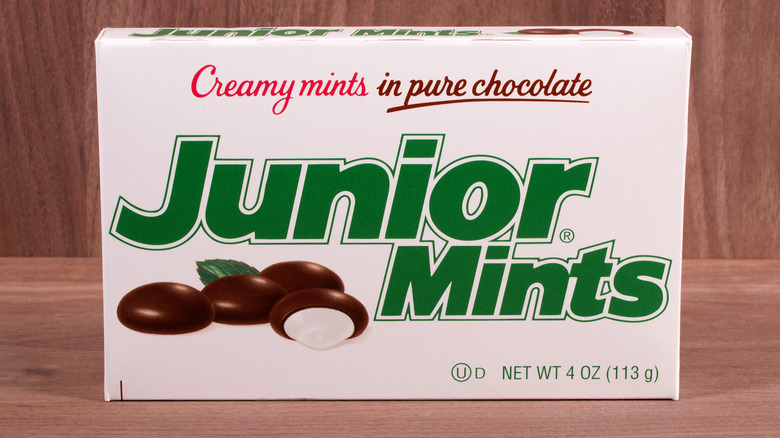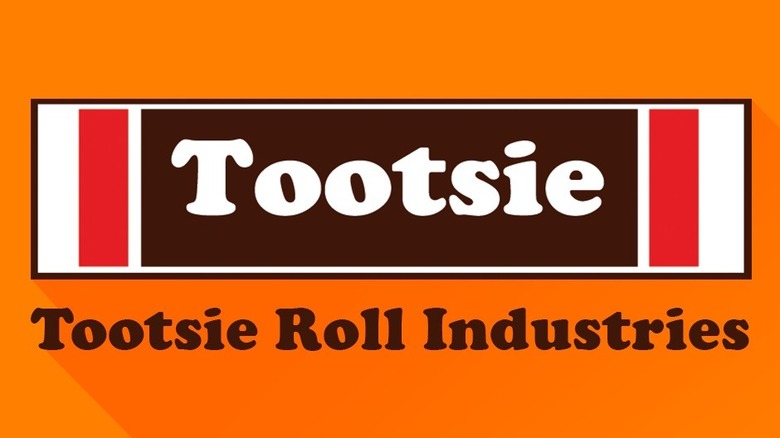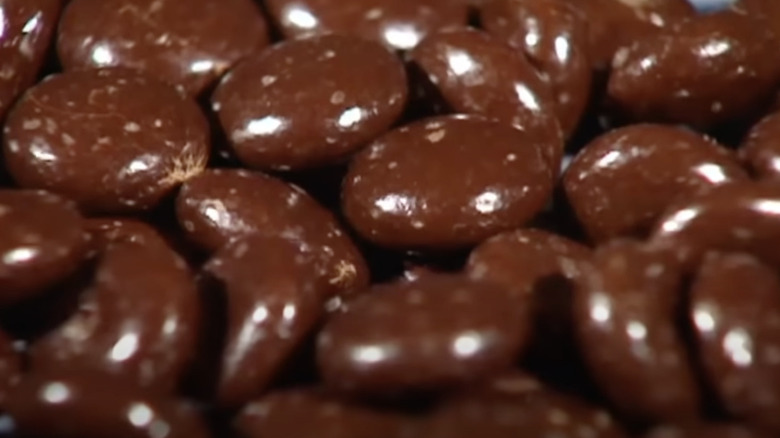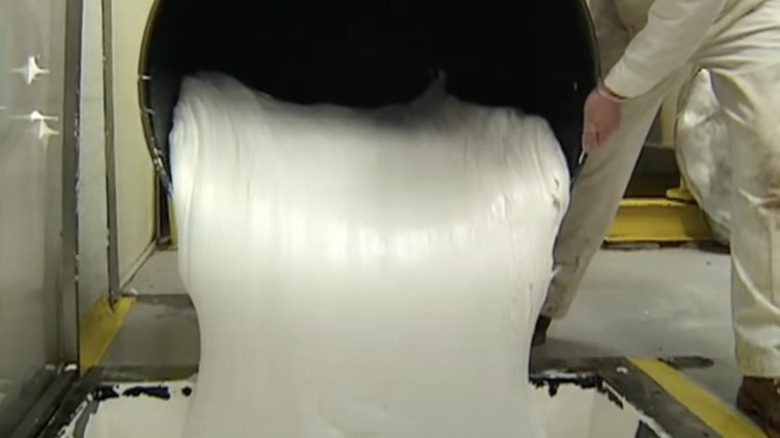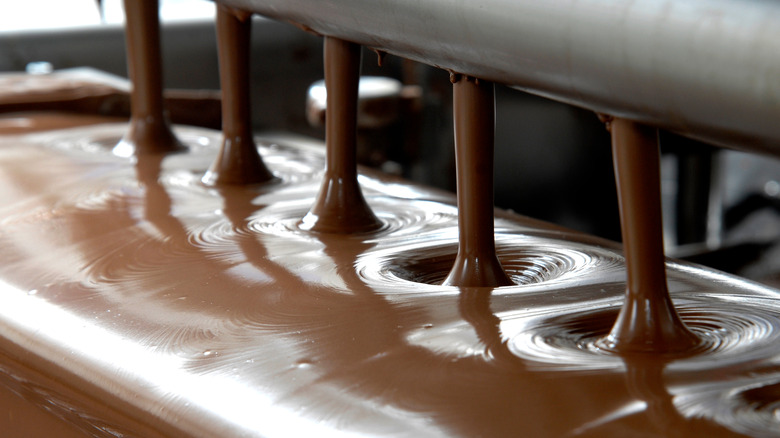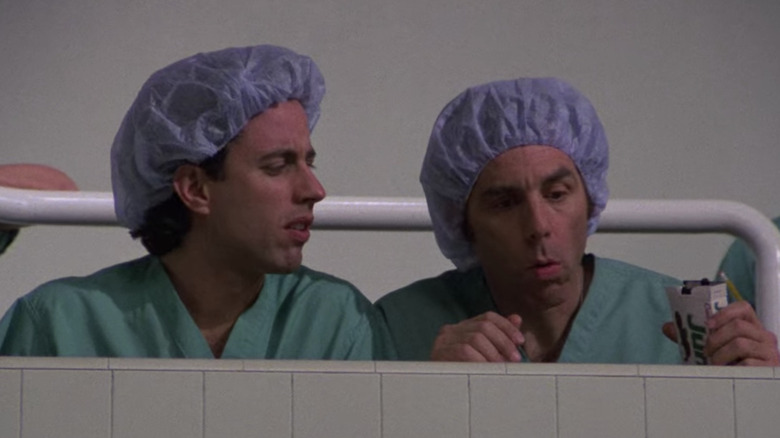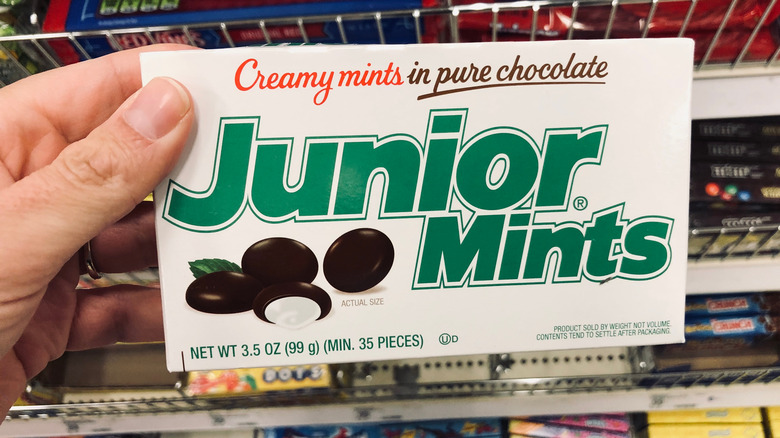The Untold Truth Of Junior Mints
Junior Mints might just be the perfect candy, or at least the most crowd-pleasing. We echo the sentiments shared by Cosmo Kramer on a classic episode of "Seinfeld": "Who's gonna turn down a Junior Mint?" he declared. "It's chocolate, it's peppermint, it's delicious." There's a bit more to the Junior Mint than that — each tiny bite-sized nugget of cooling, creamy, velvety sweetness consists of mint that's not quite solid, not quite liquid, wrapped up in several rounds of thick, dark, and shiny chocolate. The can't-eat-just-one treat has been a popular favorite for decades, launched and produced in the United States not long after World War II. It's now firmly part of the landscape of American food culture. If there's ever a movie theater candy hall of fame, that distinctive white-and-green box of Junior Mints is a first-ballot inductee.
For such a comforting candy that made new use of the familiar combination of chocolate and mint, Junior Mints have enjoyed a long, colorful, and sometimes mildly controversial history. Here's a look at the anything but small life of Junior Mints.
A lot of different companies have made Junior Mints
According to Beth Kimmerle's "Candy: The Sweet History," Junior Mints were born in 1949, a product of The James O. Welch Company, the same firm that had previously introduced candy buyers to the Sugar Daddy (originally the Papa Sucker), Sugar Babies, and Charleston Chew. The matter of who owns the rights to and produces Junior Mints depends on what year it is. According to The Cambridge Historical Society, Junior Mints were produced by The James O. Welch Company until 1963, when food conglomerate Nabisco bought the candy maker. (James Welch was tapped to serve as a director at the company.)
But then in 1988, Nabisco sold it to The Warner-Lambert Company, a pharmaceutical maker (per The New York Times). Junior Mints (and Charleston Chew, Sugar Daddy, Sugar Babies, and Pom Poms, among other candies) remained the purview of that corporation until 1993, when Warner-Lambert sold off its candy brands to Tootsie Roll Industries which continues to produce the candy.
Junior Mints are named after a play
The name "Junior Mints" is ideally suited to the product — while memorable and jaunty, it's quite literal too, as the candy is small (or junior) pieces of mint, coated in chocolate. And yet, the creators of Junior Mints didn't pick that name to be as direct and descriptive as possible — it's actually a play on the name of a mostly forgotten pop culture phenomenon from long ago. According to Andrew F. Smith's "Fast Food and Junk Food," the makers of Junior Mints claim that James O. Welch, head of original producer the James O. Welch Company, personally named the treat after "Junior Miss," a popular Broadway play based on a collection of widely read New Yorker stories by Sally Benson. The play ran for two years (1941 to 1943), and it was later adapted into a radio show starring superstar Shirley Temple.
By 1949, when Junior Mints launched, "Junior Miss," in its many forms, had long-since peaked in popularity. But consumers of the era probably understood the joke of the candy's name, perhaps having their memories of the play jogged by Junior Mints' presence at movie theater concession stands.
Producing Junior Mints is a complicated process
Chocolate and mint are a common combination. But the way Junior Mints bring them together is a little bit different than other confections, according to Richard W. and AnnaKate Hartel's "Candy Bites: The Science of Sweets." First, sugar and corn syrup are mixed and cooked, then quickly cooled and left alone, whereupon it's thoroughly agitated and stirred in order to get the sugar to crystallize. That makes a goop that's sort of crystalline, and sort of liquid.
That mixture is then combined with frappé, a whipped, marshmallow-like concoction of sugar, corn syrup, gelatin, and egg protein. The proteins in the frappé maintain the structural integrity of the sugar crystals as the now mostly fluid, mint-flavored white stuff is sent to rubber candy molds that shape out individual half-spheres. A conveyor takes the candy through a cooling chamber, allowing the sweet solution to set and firm up, which comes in large part by the continuing crystallization of the sugar molecules. Once the mints are hard, they're sent to a tumbler, where they're sprayed with liquid chocolate a few times until covered in a several thick layers. After sitting until the next day to allow the chocolate to firm up, the Junior Mints receive a coating of confectioners glaze, which gives the candy its distinctive sheen.
Every Junior Mint is still made in the original factory
In the early 20th century, the Boston suburb of Cambridge was unofficially the United States' candy capital. By 1946, according to the Boston Globe, 66 different companies operated factories in the Cambridge area, many of them centralized in one area nicknamed Confectioner's Row. One such facility, known as Cambridge Brands, was erected in 1927 for The James O. Welch Company. By 1949, production began on Junior Mints (via OldTimeCandy.com).
As the candy industry became more corporatized and consolidated in the later years of the 20th century, more and more plants shut down or moved to the point where Cambridge Brands was the last factory standing from Cambridge's golden years. And yet, still every single one of the chocolate-covered mints is produced at the Cambridge factory. Employing only about 200 people, the facility (which forbids tours and only rarely allows visitors) cranks out not just Junior Mints, but the global supply of Sugar Babies and Charleston Chew, too. About 26.5 million pieces of candy come off the line each day, of which 14.56 million are Junior Mints.
Why Junior Mints showed up on 'Seinfeld'
Thanks to being an integral part of the plot of one of the most-highly regarded installments of legendary sitcom "Seinfeld," Junior Mints have solidified their pop culture legacy. The episode involving a rogue Junior Mint is actually titled "The Junior Mint." When Roy (Sherman Howard), a former flame of Elaine (Julia Louis-Dreyfus), ends up in the hospital for surgery, Kramer (Michael Richards) and Jerry (Jerry Seinfeld) decide to watch it from above, in the operating theater. Kramer brings along a box of Junior Mints to snack on, and insists Jerry take one. He's not in the mood and he bats Kramer's arm away, causing the Junior Mint to fall directly into the patient's abdominal cavity. Roy suffers complications but then miraculously gets better, which a doctor humorously credits to "something from above."
Junior Mints come off really well on "Seinfeld." According to Brands and Films, the mint got the call only after the makers of M&M's and Lifesavers said no. "Some companies didn't want to see their candy falling into the cavity of a patient: They overanalyzed it and lost the humor in it," said Patricia Ganguzza, owner of product placement agency AIM Promotions. Reportedly, Junior Mints' manufacturer didn't receive any money for the inclusion, although the actual piece of candy used as the prop in the surgery scene was a York Peppermint Patty — the Junior Mint was too small to show up properly on camera.
Junior Mints were central to a lawsuit
Many snack and candy packaging — particularly "movie theater"-size boxes of sweets — are often very large, leading to the assumption by the consumer that they're about to buy a massive load of candy. However, those containers are subject to "slack-fill," which just means that there's a lot of air inside, either to protect the product inside or because the items may shuttle during the shipping process.
In 2018, per Reuters, U.S. District Judge Naomi Reice Buchwald heard a case alleging deceptive business practices on the part of Tootsie Roll Industries. Plaintiffs Biola Daniel, Abel Duran, and Trekeela Perkins alleged fraud because 35 to 43 percent of the boxes of Junior Mints they'd purchased consisted of air, leading them to believe that they overpaid for what candy they actually received. Judge Buchwald wrote a 44-page decision dismissing the suit entirely, stating that no fraud occurred because a Junior Mints buyer could have figured out exactly how much candy was in the box by reading the weight of the product clearly written on the packaging. "Assuming that a reasonable customer might ignore the evidence plainly before him attributes to consumers a level of stupidity that the court cannot countenance," Buchwald wrote.
